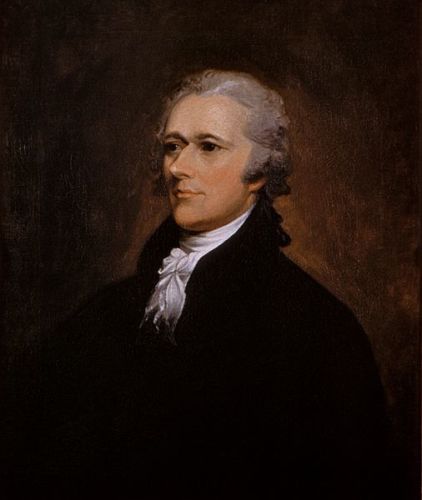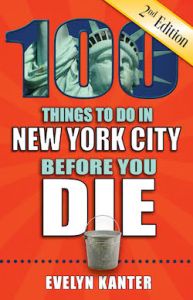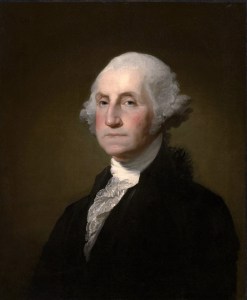
Hamilton opened on Broadway five years ago today, on August 6, 2015, and became an overnight blockbuster.
See Hamilton in NYC for FREE or for less than the price of his picture on a $10 bill, at these locations where Alexander Hamilton lived, worked, ate, and died, and where Lin-Manuel Miranda was inspired to write much of the show.
The popularity of Hamilton on Broadway, which won 11 Tony Awards, has made anything related to Hamilton in New York City popular, and that interest has been renewed with the release of the film version, now streaming on Disney Plus.
In honor of the Broadway opening anniversary, we are republishing this guide to Hamilton’s life in New York City.
Note that inside access to several Hamilton-related sites are currently closed by the pandemic, but we are providing pre-pandemic information in the hopes normalcy will return soon.
Daveed Diggs, Okieriete Onaodowan, Anthony Ramos, and Lin-Manuel Miranda in the original Broadway cast of Hamilton. Photo © Joan Marcus via TheaterMania
Stay up to date with all things Hamilton
on the
NYCOTC Hamilton hub page
Hamilton Grange National Monument
Hamilton built this Federal-style house in 1801 as a country retreat, back when this part of upper Manhattan was still farmland.
The floor-to-ceiling windows offer commanding views from the hilltop location, and the surrounding park is lovely.
The neat row houses on the streets around the house were built in the early 20th century on land Hamilton once owned.
National Park Service Park Rangers are expected to resume hourly tours when NYC fully re-opens.
Because of Hamilton’s superstar status, reservations are absolutely recommended.
Hamilton Grange National Monument is at 141st St. and Convent Ave., just north of CUNY.
Where is Hamilton Buried
Hamilton is buried in Trinity Churchyard, adjoining Trinity Church, in the shadow of the World Trade Center.
Miraculously, both the church and churchyard escaped destruction on September 11, 2011, as did sister church St. Paul’s Chapel and its equally historic churchyard, a few blocks away.
Hamilton, his wife, Eliza, and their eldest son, Philip are buried at Trinity Churchyard, along with other Revolutionary Era notables. One of those is Robert Fulton, inventor of the steamboat which helped make NYC one of the world’s busiest ports and a world financial center.
That was surely appreciated by Hamilton, who created the American financial system, including a mint with the dollar as currency.
Another notable Revolutionary buried here is John Peter Zenger (1697–1746). He is the newspaper publisher whose libel trial helped establish the right to a free press, so central to the democracy known as the United States of America. Zenger and Hamilton were friendly rivals.
Hamilton, who wrote most of the Federalist Papers, also founded the New York Evening Post in 1801. It’s still publishing today, as the New York Post, although more famous today for its celebrity gossip Page Six than for the insightful political articles of Hamilton’s day.
Trinity Church is at 75 Broadway, so - yes - you can tell your friends you really did see Hamilton on Broadway.
Be sure to go inside St Paul’s Chapel to see the pew where George Washington worshipped, and the memorial to 9-11 First Responders with hundreds of badges and other mementos.
St. Paul’s was used as a refuge by First Responders, who often slept on the wooden church pews.
We hope that when NYC fully re-opens there will once again be free concerts and other events here.
St. Paul’s is on the corner of Vesey St. and Fulton St., named for Robert Fulton, inventor of the steamboat. Fulton is buried in Trinity Churchyard, near the Hamiltons.
There’s also a Trinity Graveyard and Mausoleum uptown, in Washington Heights, just north of what is now called Hamilton Heights.
Famous souls resting here include naturalist John James Audubon, beloved actor Jerry Orbach, beloved former NYC Mayor Ed Koch, Eliza Bowen Jumel, ex-wife of Aaron Burr.
Another famous New Yorker buried here is Clement Clarke Moore, author of the beloved poem A Visit from St. Nicholas, which begins with the phrase “Twas the night before Christmas, and all through the house…”. There’s a reading of the famous poem at Moore’s gravesite each holiday season.
Download the FREE Trinity Church mobile app for a virtual guided tour of all three sites.
Morris-Jumel Mansion
Built in 1765, this is the oldest surviving private dwelling in Manhattan, filled with Georgian, Federal and French Empire furnishings from its various owners, and a convoluted history that reads like a pulp novel.
Like Hamilton Grange, it was built as a country getaway, by British officer Roger Morris (nearby Mount Morris is named for him) and his wife, Mary Philipse, part of the wealthy family which owned much of what is now Westchester County. The Morris estate stretched over 130 acres from the Harlem to the Hudson Rivers.
The couple abandoned their home during the American Revolution because they were Tories.
The home became the headquarters of George Washington in the fall of 1776, in part because of its strategic location, at one of the highest points in Manhattan. The new American government confiscated the house and its surrounding property after the war.
Washington used the mansion again a few years later for the very first presidential cabinet meeting, which included both Secretary of the Treasury Alexander Hamilton and lifelong rival Aaron Burr.
There are other Hamilton connections, too.
In 1810, French merchant Stephen Jumel purchased the house for himself and his wife, wealthy socialite Eliza Bowen.
After Jumel’s death, Eliza married Hamilton’s political rival, Aaron Burr in the front parlor, soon after the famous duel in which Hamilton died. It was not a happy marriage, and she kicked him out after less than a year.
Their divorce was final on Sept. 14, 1836, the day Burr died in Staten Island. In another historic twist, Eliza’s lawyer was Hamilton’s son.
Eliza Bowen’s ghost is said to haunt the place, and there are paranormal tours here.
Lin-Manuel Miranda was inspired to write some of the Hamilton musical here. He wrote the hit song “In the Room Where it Happens” in Burr’s bedroom.
The Morris Jumel Mansion is part of the Historic House Trust of NYC, at 65 Jumel Terrace, at 160th Street east of Broadway.
- The Morris-Jumel Mansion website has a video intro by Lin-Manuel Miranda.
- Read secrets of the Morris-Jumel Mansion.
Hamilton Hall, Columbia University
Alexander Hamilton came to New York in 1772 as a young man who had been born out of wedlock in the tiny Caribbean island of Nevis. His illegitimate status meant few prospects for advancement at home for a brilliant and studious young man.
Hamilton came to New York to study at King’s College, which would later be known as Columbia University.
It was here that Hamilton became involved in the growing revolutionary cause, made his first public speeches for independence, and became a loyal and trusted assistant to General George Washington.
A centerpiece of today’s campus is Hamilton Hall, a 1907 structure designed by McKim, Mead & White, with a statue of the famous student standing outside the front entrance.
Fraunces Tavern
This historic watering hole played an enormous role in Revolutionary-era history. It’s also one of New York City’s oldest buildings, a sturdy brick building dating to 1719.
The Sons of Liberty gathered here in secret to hash out their plans. Gen. Washington said a fond farewell to his officers here, in what’s called the Long Room (pictured here) and where several branches of the new government had their offices before relocating to Philadelphia and, eventually, Washington, D.C.
It is less well known that Hamilton and his longtime foe, Aaron Burr, then Thomas Jefferson’s Vice President, shared a tense supper at Fraunces Tavern on July 4, 1804.
Just one week later, Hamilton and Burr would fight their infamous duel, and Hamilton would die of his wounds.
Fraunces Tavern still serves food and drink downstairs, and there’s a small museum upstairs.
Fraunces Tavern is at 54 Pearl St. at Broad St.
Where to See Statues of Hamilton
Central Park - A larger-than-life-size statue of Hamilton marks the entrance to Central Park’s East Drive at 83rd Street, near the Metropolitan Museum of Art.
It is unusual because it is carved entirely of granite, including the base. Hamilton’s grandson John C. Hamilton donated the piece to New York City in 1880.
Hamilton Heights - There’s a bronze statue of Hamilton at St. Luke’s Episcopal Church in Hamilton Heights, where he worshipped.
Columbia University - There’s another Hamilton statue in front of Hamilton Hall at Columbia University, his Alma Mater, then known as Kings College.
Museum of American Finance
Hamilton was the nation’s first Secretary of the Treasury, who created the nation’s banking system, so he would have loved this museum, which is housed in the former Bank of New York building on Wall St., founded by Alexander Hamilton.
The Hamilton Room is a permanent exhibit on Hamilton and his impact on world commerce, and you can drool over gold coins from around the world, and more. Interactive exhibits make this fascinating for all ages.
The Museum of American Finance is at 48 Wall St. at the corner of William St., close to both the New York Stock Exchange and Federal Hall National Monument, where Washington took the oath of office as first US President, when New York City was the nation’s capital.
See also our guide to
Where Washington Worked, Ate & Worshipped in NYC

Federal Reserve Bank Gold Vault Tour
Show me the money!
There’s as much as $100 Billion in bills and gold stashed beneath the Federal Reserve Bank of New York, and you can see at least some of it FREE.
Tours are weekdays, except when there’s a bank holiday or a security threat locks down the place.
Speaking of security - no cameras or camera-equipped mobile devices are allowed. Stash them in secure lockers.
Only 25 visitors at a time are permitted on the tours, and you must make your reservations online ahead of time and bring the printed ticket for admission. I recommend early afternoon, after the school groups have left.
The Federal Reserve Bank is at 33 Liberty St.
Aaron Burr’s Carriage House and horse stable
The Vice-President’s former “garage” in Greenwich Village is now one of the most romantic and expensive restaurants in New York City.
One if by Land, Two if by Sea is in a landmarked building dating from 1767.
If dinner is too pricey for you, stop in for a drink at the bar. Bartenders are quite used to talking about the iron rings attached to the wall, where Burr’s horses were tethered.
Weehawken Dueling Grounds
In the early 1800s, NYC had its own official dueling grounds, just across the Hudson River on the bluffs of New Jersey.
The Weehawken Dueling Grounds were a notorious spot where opponents settled their differences at 20 paces with single shot dueling weapns.
The duel here between Alexander Hamilton and Aaron Burr in 1804 was the culmination of decades of competition and animosity between the two, apparently brought to the boiling point when Hamilton publicly slandered Burr in his bid to become governor of New York State.
Historians have argued over whether or not Hamilton deliberately missed Burr, wasting his shot. We’ll never know. Burr’s bullet struck Hamilton in th side, mortally wounding him.
In another one of those ironic twists of fate, Hamilton’s son, Phillip, had been killed in a duel on the same spot just three years earlier.
The site is tough to find.
It has been covered by train tracks, but there’s an small monument nearby that you can visit, and a plaque detailing the history of the grounds along with a bust of Hamilton at the spot where he is believed to have collapsed.
 100 Things to Do in NYC Before You Die
100 Things to Do in NYC Before You Die
Some of these NYC attractions are included in the new NYC guidebook by NYC on the Cheap Editor Evelyn Kanter.
Order on Amazon or Barnes & Noble.
Or email me for an autographed copy. [email protected]
photos courtesy NYC Parks Dept, Wikipedia Commons, MorrisJumel.org, National Park Service, Museum of American Finance, Federal Reserve Bank
This article was published originally in 2016, when the Hamilton show opened on Broadway, and has been updated for the release of the film version in 2020



I thought I’d seen everything in NYC. I’m going to check these sites out the next time I’m in NYC.